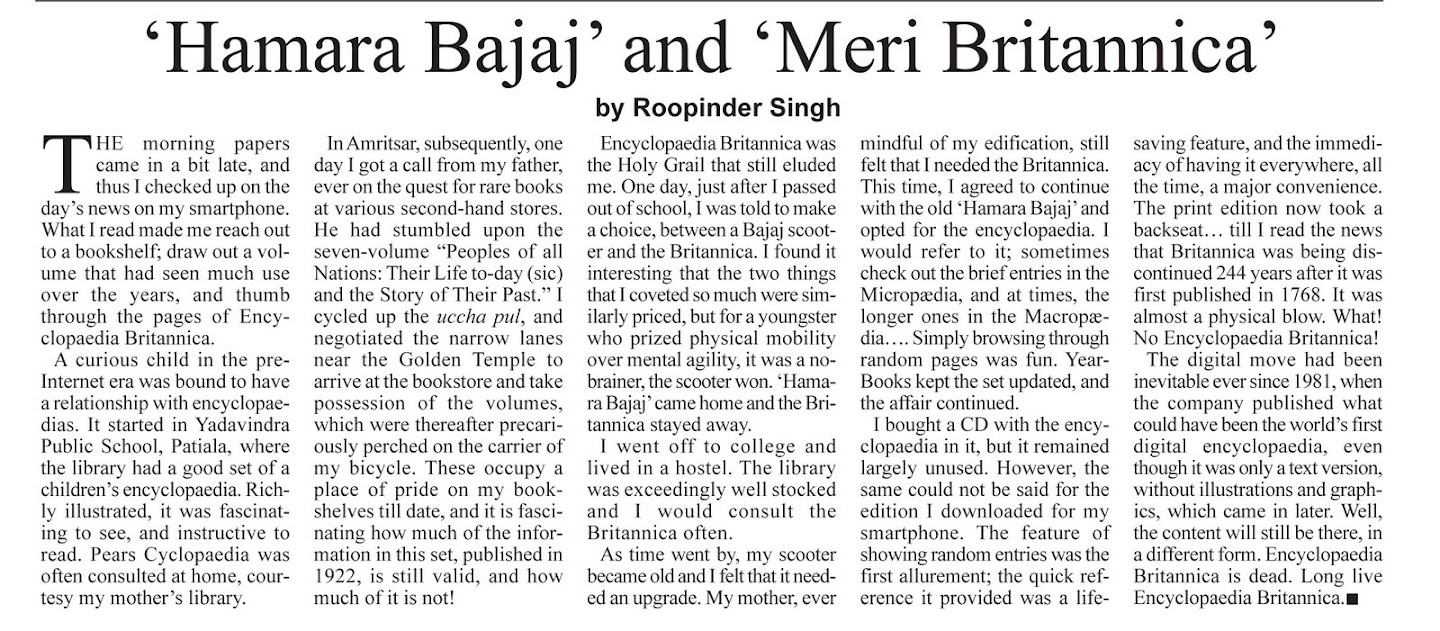by Roopinder Singh
THE morning papers came in a bit late, and thus I checked up on the day’s news on my smartphone. What I read made me reach out to a bookshelf; draw out a volume that had seen much use over the years, and thumb through the pages of Encyclopaedia Britannica.
A curious child in the pre-Internet era was bound to have a relationship with encyclopaedias. It started in Yadavindra Public School, Patiala, where the library had a good set of a children’s encyclopaedia. Richly illustrated, it was fascinating to see, and instructive to read. Pears Cyclopaedia was often consulted at home, courtesy my mother’s library.
In Amritsar, subsequently, one day I got a call from my father, ever on the quest for rare books at various second-hand stores. He had stumbled upon the seven-volume “Peoples of all Nations: Their Life to-day (sic) and the Story of Their Past.” I cycled up the uccha pul, and negotiated the narrow lanes near the Golden Temple to arrive at the bookstore and take possession of the volumes, which were thereafter precariously perched on the carrier of my bicycle. These occupy a place of pride on my bookshelves till date, and it is fascinating how much of the information in this set, published in 1922, is still valid, and how much of it is not!
Encyclopaedia Britannica was the Holy Grail that still eluded me. One day, just after I passed out of school, I was told to make a choice, between a Bajaj scooter and the Britannica. I found it interesting that the two things that I coveted so much were similarly priced, but for a youngster who prized physical mobility over mental agility, it was a no-brainer, the scooter won. ‘Hamara Bajaj’ came home and the Britannica stayed away.
I went off to college and lived in residence. The library was exceedingly well stocked and I would consult the Britannica often. My class-fellow, Bikram Kirti Singh De’s father Sudhendra Narayan Singh Deo featured in the edition that we had in college at that time, not because of his royal connection with Seraikella, but because of his contribution to Chau Dance for which was honoured by the Government of India with the Sangeet Natak Akademi Award in 1962 and also with the Padmashri.
As time went by, my scooter became old and I felt that it needed an upgrade. My mother, ever mindful of my edification, still felt that I needed the Britannica. This time, I agreed to continue with the old ‘Hamara Bajaj’ and opted for the encyclopaedia. I would refer to it; sometimes check out the brief entries in the Micropædia, and at times, the longer ones in the Macropædia…. Simply browsing through random pages was fun. Year-Books kept the set updated, and the affair continued. Encyclopaedia Britannica remained in my life long after the scooter scooted out of it.
I bought a CD with the encyclopaedia in it, but it remained largely unused. However, the same could not be said for the edition I downloaded for my smartphone. The feature of showing random entries was the first allurement; the quick reference it provided was a life-saving feature, and the immediacy of having it everywhere, all the time, a major convenience. The print edition now took a backseat… till I read the news that Britannica was being discontinued 244 years after it was first published in 1768. It was almost a physical blow. What! No Encyclopaedia Britannica!
The digital move had been inevitable ever since 1981, when the company published what could have been the world’s first digital encyclopaedia, even though it was only a text version, without illustrations and graphics, which came in later. Well, the content will still be there, in a different form. Encyclopaedia Britannica is dead. Long live Encyclopaedia Britannica.
A slightly shorter middle on this topic was published in The Tribune on March 16, 2012

